Sichuan Spicy Hot Pot (麻辣火鍋)
Warning: Parameter 2 to wp_hide_post_Public::query_posts_join() expected to be a reference, value given in /home/yirese5/public_html/wp-includes/class-wp-hook.php on line 287
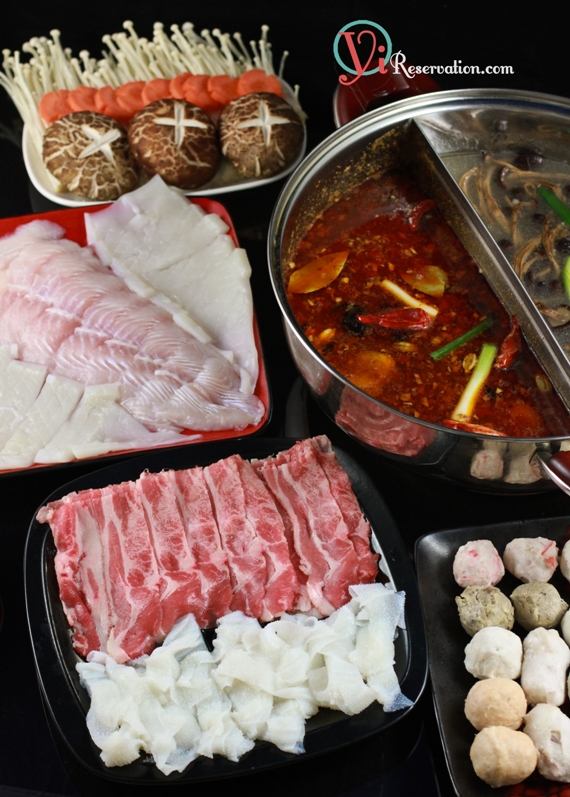
This is Part II of the Hot Pot Series. Here are the other posts in this series:
Part I – Introduction to Chinese Hot Pot
Part III – Clear Soup Hot Pot
Part IV – Quick and Easy Sichuan Spicy Hot Pot
In Part I of this Hot Pot Series, I talked about the origin and culture of this traditional Chinese communal meal. Today, I’d like to introduce you to my favorite type of hot pot: the famous Sichuan (Szechuan)Spicy Hot Pot.
As the name suggested, Sichuan hot pot was originated from Sichuan Province which is known for its appetite for spicy food. This mouth-burning and tongue-numbing hot pot has been gaining enormous amount of attention in recent years in the States. With Sichuan hot pot restaurants springing up in New York City, I figure I’d first give a brief history of this new sensation.
The commonly accepted theory traces the Sichuan Hot Pot back to early 20 century. At the time, the port workers and fishermen worked and lived along the Yangtze River could not afford to eat the regular cuts of meat so they figured out a way to cook cheap meats and offal by boiling them in a pot of extremely spicy broth. The use of spicy broth was first intended to disguise the faulty taste from the offal. However after some modification and addition of fragrant spices, this one pot meal became a popular dish in Sichuan region.
After years of continuous development, the Sichuan Hot Pot today is much more refined and no longer a meal for the lower-class. Although offal still remains as classic hot pot ingredients, high quality meats and seafood ingredients are also common on the menu. The modern hot pot has been shape into a progressive meal that starts with sliced meat, offal, and seafood followed by vegetables and ends with noodles.

As I mentioned in part I of the series, eating hot pot is a slow and interactive meal. You poach your raw ingredients in the boiling broth and at the same time engage in a conversation with your friends and family. To that reason I prefer to prepare the meal at home.
For a quick hot pot at home, I only include a handful of my favorite ingredients to save some prep time and avoid too much leftover. I like to do a combination of red meat, meat ball, fish, squid, mushrooms, and green vegetables. You can find a list of common ingredients in my hot pot introduction article.
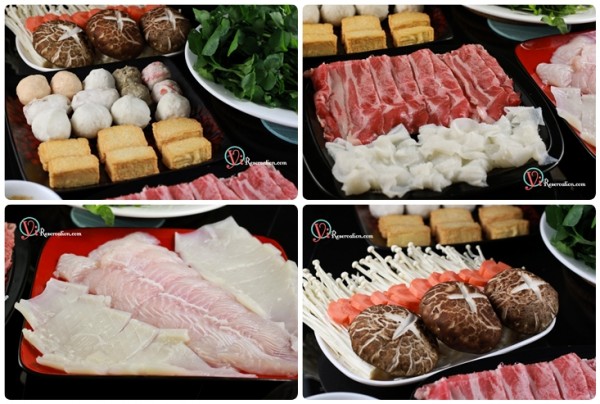
There are pre-made mix packages you can buy at Asian grocery stores (use it if you really can’t do it from scratch) but I like to make my own spicy broth from scratch according to my own taste. I know it might sound crazy but it’s really not that bad plus you can do thing in bulk for multiple uses. Here are some of the ingredients and condiments needed to make the Sichuan spicy hot pot broth:
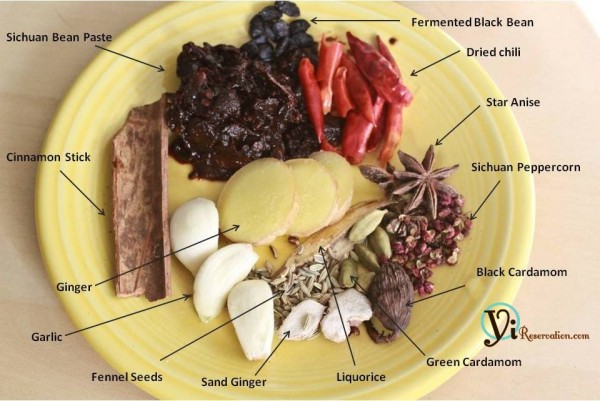
Step-by-step instruction:
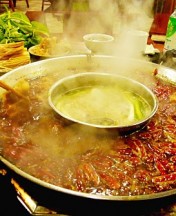
Yield: 1/2 12" special pot
Prep Time: 30 mins
Cook Time: 120 mins
Total Time: 150 mins
Ingredients:
Aged-spicy paste (adjust to your own spiciness)
- 3 tbsp Sichuan Spicy Bean Paste
- 5 Dried chili, soaked until soft.
- 1 tbsp Chinese Black Bean
- 4 slice Ginger, 4 glove Garlic
- ½ cup Cooking Wine
- 1tbsp Rock Sugar
For the stock
- 2 lb Beef or Pork or Chicken bones
- 3 slice Ginger
- 2 Scallion
- 3 Bay leaf
- 1 gallon water
Directions:
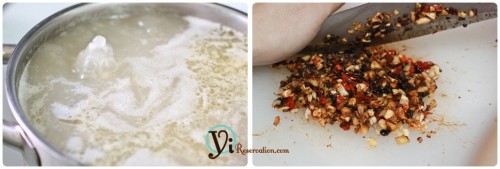 Combine 4 tbsp of oil and all the chopped ingredients, cook in low heat for 10 minutes. Stir frequently. Add the rest of the dry spices and cooking wine and sugar to the paste. Continue to cook in low heat for another 30 minutes then turn off the heat. This is your aged-spicy taste and can be made in advance.
Combine 4 tbsp of oil and all the chopped ingredients, cook in low heat for 10 minutes. Stir frequently. Add the rest of the dry spices and cooking wine and sugar to the paste. Continue to cook in low heat for another 30 minutes then turn off the heat. This is your aged-spicy taste and can be made in advance.
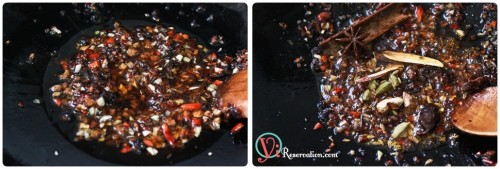 Before serving the hot pot, combine the aged-spicy paste with base stock and bring to boil. Add additional ginger, dried chili, and salt to taste.
Before serving the hot pot, combine the aged-spicy paste with base stock and bring to boil. Add additional ginger, dried chili, and salt to taste. 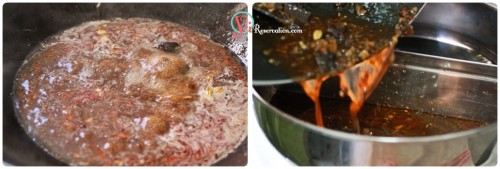 To make the special peanut butter sesame dipping sauce, combine the peanut butter, sesame paste, and fermented bean curd. Mix into a paste. Add oyster sauce, sugar, chopped chive flower and mix well.
To make the special peanut butter sesame dipping sauce, combine the peanut butter, sesame paste, and fermented bean curd. Mix into a paste. Add oyster sauce, sugar, chopped chive flower and mix well.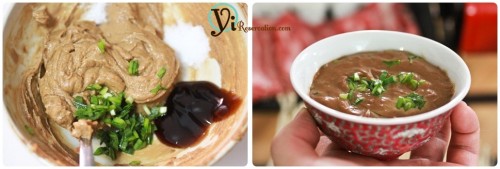
If in case you are curious about the broth on the non-spicy side, it’s made of tea tree mushroom and broth. Similar to this recipe here.
Chinese Hot Pot Equipment
The most common hot pot setup requires two pieces of equipment:
1) A single-burner tabletop stove powered by butane is normally used to serve the boiling pot. Make sure to choose a portable single- burner that can adjust the output.
2) Although any stainless steel pot can be used to serve the hot pot, I normally use a special pot with a divider in the middle so I can serve half spicy half non-spicy (known as 鸳鸯 in Chinese).
Alternatively, you can also go for an all-in-one electric setup, but I find this system lack of heat output (perhaps just the one system I have used)
On Eating the Hot Pot
Here is a quick demonstration on how to hot pot a piece of raw squid: pick up the squid with your chopsticks –> submerge it in the boiling broth for about 30 seconds -> remove from the broth and eat with your dipping sauce. For ingredients that take longer to cook, you can just let them boil for however it is needed. Just make sure someone else doesn’t take your food 🙂
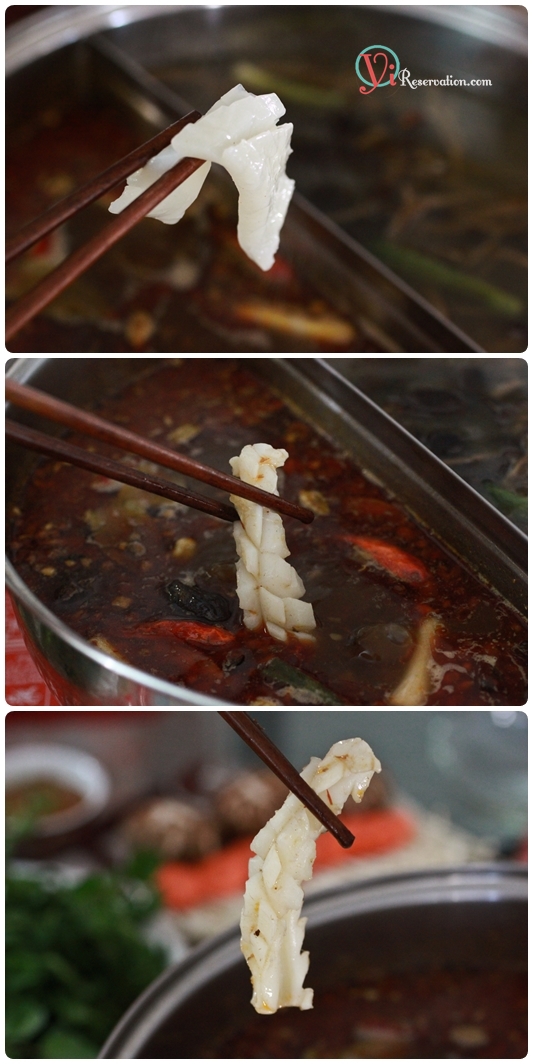
Just in case you are curious about how the authentic spicy hot pot looks like in my hometown Chongqing…..

Image taken from www.dianping.com
Enjoy hot-potting!